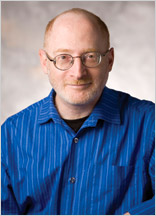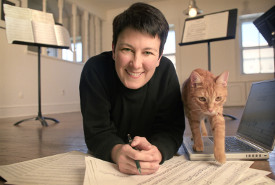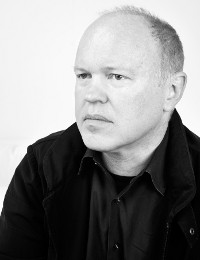With its adventurous selection of 20th and 21st Century American music along with a broader sampling from the standard repertoire, the Quad City Symphony Orchestra's upcoming season represents a sharp contrast from its most recent one. Music Director and Conductor Mark Russell Smith said in a phone interview that the challenge was "finding the right balance between the familiar and unfamiliar."
He has succeeded in both selection and placement. The award-winning contemporary American music has been sprinkled among stalwart European masters, resulting in imaginatively diverse, bold programming spanning 250 years in the six Masterworks concerts.
This year, the orchestra will present works by American composers in four of the six programs and feature two world premieres of music commissioned by the Quad City Symphony organization. "This is what I like in a season," Smith explained. "Giving composers a forum for their work" and providing a "variety, and that's what the audience likes."
The emphasis on recent American work is a significant change from last year's season, in which the musical load was borne almost exclusively by masterpieces from the late 19th Century.
Audiences shouldn't fear a season with so much new music, however. It's true that "contemporary" music has been associated with impenetrable tonal systems more encrypted for academics than designed for the entertainment of orchestra audiences. But today the term has come to include a return to familiar, consonant tonal language within perceivable forms - a rediscovery of what music critic Kyle Gann called "simplicity." For Smith, the formula for selecting new music was easy; he said he wanted composers "who have something to say and communicate directly to the audience."
The American music on this season's program represents three strains.
The first is neo-romantic, epitomized by Samuel Barber's lush, nostalgic memories of an idyllic childhood in Knoxville: Summer of 1915 (1947). Barber is one of the most celebrated American composers of the 20th Century, and his music is organized around imitating, easily recognizable themes within variations of traditional tonality and forms. His music represents a bridge from musical depictions of European literary ideas and compositional forms to an American sound and narrative.
 Aaron Jay Kernis' Musica Celestis (1990) has been called his Adagio for Strings because its intensity, beauty, and gravitas are similar to Barber's iconic composition. Kernis' musical style is a synthesis of compositional elements stretching from 19th Century neo-romanticism to today's hip-hop music. His music is passionate, innovative in a coalescence of diverse styles that is appealing to audiences, and respected by organizations that follow the evolution of musical accomplishments. He was the youngest composer to ever win the Pulitzer Prize for music - in 1998 with his String Quartet No. 2. An example of this eclectic mixture of elements is his New Era Dance, a joyful, pulsating collision of New York street music that includes the ambient sounds of police sirens and whistles.
Aaron Jay Kernis' Musica Celestis (1990) has been called his Adagio for Strings because its intensity, beauty, and gravitas are similar to Barber's iconic composition. Kernis' musical style is a synthesis of compositional elements stretching from 19th Century neo-romanticism to today's hip-hop music. His music is passionate, innovative in a coalescence of diverse styles that is appealing to audiences, and respected by organizations that follow the evolution of musical accomplishments. He was the youngest composer to ever win the Pulitzer Prize for music - in 1998 with his String Quartet No. 2. An example of this eclectic mixture of elements is his New Era Dance, a joyful, pulsating collision of New York street music that includes the ambient sounds of police sirens and whistles.
The second strain is atonal or indistinct tonality, employing variations of pitch and rhythm that resemble, but are not the same as, the serial methods of Elliott Carter, George Crumb, and others. This strain is not key-centered but based on freely improvised "performances." The composer records ideas on a piano or computer, for example, and then scores the results for the desired ensemble. These pieces are organized by intuitive decisions made by the composer in the moment, rather than conforming to any extrinsic design (sonata-allegro, rondo, etc.).
 Jennifer Higdon's Pulitzer Prize-winning Concerto for Violin (2009) was written with an improvisational process that, she revealed in an exchange of e-mails, had "no plan, no pre-determined scales, no established form, [and] no generated harmonic motion" as it was being created. She wrote that "it evolved from the technical idiosyncrasies of violinist Hilary Hahn," one of Higdon's students at the Curtis Institute of Music. Hahn's aggressive playing and finger technique allowed for an "expansion in the possibilities for the violin" that Higdon explored in the concerto, she said.
Jennifer Higdon's Pulitzer Prize-winning Concerto for Violin (2009) was written with an improvisational process that, she revealed in an exchange of e-mails, had "no plan, no pre-determined scales, no established form, [and] no generated harmonic motion" as it was being created. She wrote that "it evolved from the technical idiosyncrasies of violinist Hilary Hahn," one of Higdon's students at the Curtis Institute of Music. Hahn's aggressive playing and finger technique allowed for an "expansion in the possibilities for the violin" that Higdon explored in the concerto, she said.
Jacob Bancks uses a musical language and approach that are similar to Higdon's, but he applies a more deliberate use of form. His piece in the upcoming season will be one of two commissioned works for the Quad City Symphony. A faculty member at Augustana College, Bancks recognizes that many modern and historical compositional elements influence his musical style, specifically Luciano Berio, Toru Takemitsu, William Byrd, Beethoven, and Debussy. "I have the instrumentation, duration, and a concept - the Rock and Mississippi Rivers," he told the River Cities' Reader earlier this month. "I just don't have the notes yet." (Bancks has agreed to let the Reader follow the evolution of his piece from inception to world premiere.)
 The last strain of American classical music is represented by post-minimalist Michael Torke, who was also commissioned to create a piece by the Quad City Symphony. Oracle (2013), Torke said in a phone interview, is a "high-energy, blistering five-minute opening work" that he wants to be fun for the orchestra to play and exhilarating to listen to. Celestial in its wide array of orchestral colors, it could concisely be described as Balinese gamelan meets American bluegrass.
The last strain of American classical music is represented by post-minimalist Michael Torke, who was also commissioned to create a piece by the Quad City Symphony. Oracle (2013), Torke said in a phone interview, is a "high-energy, blistering five-minute opening work" that he wants to be fun for the orchestra to play and exhilarating to listen to. Celestial in its wide array of orchestral colors, it could concisely be described as Balinese gamelan meets American bluegrass.
His style employs scale-derived harmonies, slowly adding or subtracting notes or beats from repeating sequences of jazzy riffs, with accumulating changes in dynamics producing incantation-like effects. A self-described synesthete, he occasionally incorporates color through multimedia additions to performances; Ecstatic Orange and Bright Blue Music are part of his suite of "Color Music," for example. But, as Oracle is a short opening piece, he chose to leave the orchestra unaltered. Torke first rose to national prominence with the success of Javelin, commissioned for the 1996 summer Olympics. Smith was enthusiastic that "things came together to make the commission possible" with "someone like Torke, who is really famous and could open the new season."
This season's contemporary compositions will challenge both the players and the audience, but concert planners have wisely placed them near the familiar. The music of Torke and Kernis will kick off the season in early October with Britten's Young Person's Guide to the Orchestra and Brahms' Piano Concerto No. 1.
In late October, the orchestra shifts gears into what Smith called an intimate "salon, chamber-music setting" that is apposite for the inspired pairing of Barber's delicate Knoxville with Mozart's Ch'io mi scordi di te - a concert aria of bitter/sweet love in Vienna - and Richard Strauss' setting of Morgen!, based on a German love poem.
For December, Higdon's dense, angular, and gestural concerto appears on a program with Rachmaninoff's ubiquitously melodic and traditionally constructed Symphony No. 2.
Included with symphonies by Beethoven and Brahms in March will be the as-yet-uncomposed 10-minute piece by Bancks.
With both Bancks and Torke present for their world premieres, opportunities for discussion - at the Thursday lectures in the Hotel Blackhawk and pre-concert talks in the hall - can provide additional insight into the creative process of living composers.
For more information on the Quad City Symphony Orchestra, visit QCSymphony.com.
Frederick Morden is a retired orchestra-music director, conductor, composer, arranger, educator, and writer who has served on the executive board of the Conductors Guild. He can be reached at f.morden@mchsi.com.










